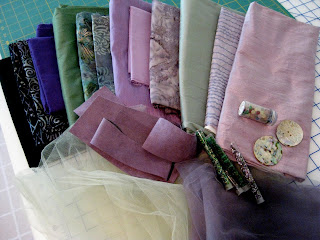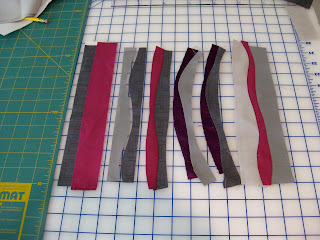Jill....It's Tuesday again--nothing like a deadline. This past exploration is a work in progress, but I have learned a few technicalities along the way.
- tighten stitch length
- narrow seam allowances are good to curve, but if too small they do not press well to one side or the other
- when sub-cutting your strip sets keep them relatively straight until making your curved cut with strips overlapped
- give extra width on these strip sets for cutting curves and seam allowances
- when planning strip sets, end and start with different fabrics, so when they are sewn end to end they maintain their variety
- when joining two long strips together, it might be best to sew from the center out for better control of color placement
- when joining lots of strips the shape of the piece gets wonky, oh well.
The strip sets were auditioned against three green fabrics. To differentiate the focus strip sets from the background, I decided to use four less intense greens in strip sets made from wider and longer pieces.
So this is a preliminary study, definitely different than imagined, a work in progress. The current piece measures approximately 14 by 22 inches.
Marny....So I got distracted by the little leftover slivers from my first strip set. They sent me in a new direction. I had the tulle sitting on the work table, and suddenly it seemed like fun to try something tangential to my original plan. (of course when doesn't that seem fun??)
First I placed the slivers of strip sets on the background and then minimally pinned the tulle on top. Then I quilted through the layers trying to catch all the pieces.
Adding on was the only way to go from there. Here again I used improvisational curved piecing.
I am continuing to add in a Courthouse Log Cabin style. Wonder when it will end?
These piecing studies have proven valuable practice for a quilt I hope to make using the fabrics and embellishments shown in last week's blog. The freedom of improvisational piecing is inspirational.
I am curious where it will take me this week.
Marny....So I got distracted by the little leftover slivers from my first strip set. They sent me in a new direction. I had the tulle sitting on the work table, and suddenly it seemed like fun to try something tangential to my original plan. (of course when doesn't that seem fun??)
First I placed the slivers of strip sets on the background and then minimally pinned the tulle on top. Then I quilted through the layers trying to catch all the pieces.
Adding on was the only way to go from there. Here again I used improvisational curved piecing.
I am continuing to add in a Courthouse Log Cabin style. Wonder when it will end?
These piecing studies have proven valuable practice for a quilt I hope to make using the fabrics and embellishments shown in last week's blog. The freedom of improvisational piecing is inspirational.
I am curious where it will take me this week.

































